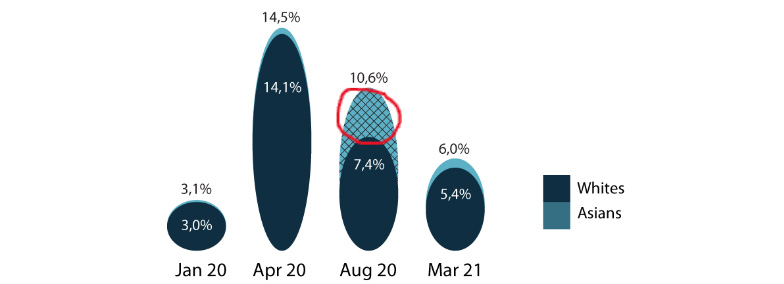The COVID-19 pandemic impacted labor markets across the board but ended up damaging some industries more than others. While some ethnic groups are more prevalent in certain industries than others, the crisis led to a wider disparity in unemployment between Whites/Asians versus African Americans/Latinos. While this difference between these two groups is clear, subtler results were also identified in our research. Asians experienced a slower re-entry into the job market than Whites.
This should be analyzed in further detail at a later posting. Latinos suffered more than African Americans, which may be linked to more precarious employment arrangements, and preferred economic sectors. Finally, African American/Latino gap in unemployment against White workers continues close to pandemic levels. We believe that its return to normal depend on two things: (i) COVID-19; and (ii) unemployment insurance checks. Both (i) and (ii) must dwindle over the summer to reduce this gap…
Introduction – The purpose of this series of postings on unemployment is to deeply analyze the US job market as a whole, through different prisms. The first posting came out in March 2021, while the pandemic was still roaring in the US. At the time, we laid out a positive outlook for adult participation in the job market. That forecast was confirmed in early May, when we published our second piece on the topic. This is the third article, and it dissects the topic transversely, across the racial spectrum. Instead of making forecasts, we look back at what happened during the pandemic, and use this analysis to see how the job market should behave in the future.
An unbalanced labor force – Traditionally, African Americans and Latinos experience unemployment at greater rates than Whites and Asians do. According to the Bureau of Labor Statistics, this gap grew during the pandemic. In 2019, the gap between African Americans and Whites averaged 2.8%, and it grew to 4.4 % in April 2020 (see the red circle). The gap between Latinos and White workers grew from 1 % to 3.4%. The graph below shows this issue in detail:

Source: Bureau of Labor Statistics, Current Population Survey
The impact of COVID-19 on Asian Americans – Historically, Asian Americans and White workers have always had similar unemployment rates. Both groups’ rates hovered around 3 – 3.1% and 14.1 -14.5% in the first two circles (January 20 and April 20). The third and fourth circle, in the height of the pandemic and now, tell a different story, as indicated in the chart below:

Source: Bureau of Labor Statistics, Current Population Survey
In August 2020, a historical gap between Whites and Asian workers – Before COVID-19, and even at the height of the pandemic, the gap was never higher than 0.4%; as one can see in the red circle, that spread reached 3.2% in August 20: Whites’ unemployment was at 7.4% while the Asians’ rate was at 10.6%. What was the reason for that gap? While it is unclear hate crimes against Asian Americans skyrocketed over that period. This gap in employment might be a reflection of that sentiment. But that deserves further analysis in a later posting.
The traditional gap: White/Asian Vs. Latino/African American workers – Three periods are illustrated below: pre-pandemic, peak levels, and current recovery. Before the pandemic, Latino and African American unemployment rates were respectively 1% and 3% higher than that of Whites.
When unemployment peaked in April 2020, it left 18.9% of Latinos unemployed, and 16.7% of African Americans unemployed. This meant a 4.7% and 2.6% spread, respectively, against Whites’ unemployment rates. Although the national rate of unemployment went down from 14.2% to 6%, the racial gap is only marginally smaller: 4.2% and 2.5% respectively. To the point that one could claim that great part of the lingering unemployment is concentrated in these two ethnic groups (hence further justifying the legitimacy of this analysis) … As one can see in the graph below:
Unemployment rate – Whites, African Americans and Latinos

Source: Bureau of Labor Statistics, Current Population Survey
Job industries might explain only part of this gap – Latinos tend to concentrate more in hospitality, leisure, restaurant, agriculture and construction. African Americans concentrate in retail and urban services. Whites and Asians concentrate in white collar professions. So, if Latinos and African Americans job industries are more severely affected, that does explain the gap across groups during the pandemic. That does not explain though why there is a gap to begin with, nor the difference in income for jobs in the same function. And to that effect, it does not explain why Asian workers were reintegrated later than Whites into the workforce.
Forecast – Economist Austan Goolsbee 1 forecasts strong hiring in industries with large Latino and African American contingents such as leisure, travel, and construction. This potential hiring frenzy in May will decrease unemployment gaps across minorities. We expect the gap to decrease to pre-pandemic levels by the end of the year to the most part, contingent on the issues below:
Reasons behind our conservative forecast – (i) delays in COVID-19 vaccination in the US and abroad will affect minorities’ job prospects; (ii) Some analysts claim that excessive stimulus payments are more or less equivalent to precarious and informal job positions, further reducing incentives for workers to join the job market at any cost; (iii) minorities have already been disproportionately affected by the disease and might decide to wait out and collect unemployment checks rather than face another death in the family due to COVID-19; (iv) job industries where minorities tend to concentrate are more likely to be temporary and precarious, (last one hired, the first one fired), which makes it harder to get a job to begin. Hence, employment will rise but minorities gap might still linger in the near future…
 Bernardo Weaver is a senior finance consultant at the World Bank Group in Washington DC and a finance professor to top investment banks and Hedge Funds in Wall Street. Mr. Weaver also teaches M&A as an adjunct professor at Georgetown McDonough School of Business and at Pepperdine University Graziadio School of Business. Mr. Weaver is a Wharton MBA grad, and holds an LLM from UConn Law, and a law degree from P.U.C.- Rio, in Brazil.
Bernardo Weaver is a senior finance consultant at the World Bank Group in Washington DC and a finance professor to top investment banks and Hedge Funds in Wall Street. Mr. Weaver also teaches M&A as an adjunct professor at Georgetown McDonough School of Business and at Pepperdine University Graziadio School of Business. Mr. Weaver is a Wharton MBA grad, and holds an LLM from UConn Law, and a law degree from P.U.C.- Rio, in Brazil.**Disclaimer**
This article was prepared exclusively for Blaylock Van, LLC. Links are solely intended for convenience and are not intended to be advertisement whatsoever. Linked sites are not under the control of Blaylock Van, LLC and Blaylock Van, LLC is not responsible for the content of any linked site or any link contained in this article. Blaylock Van, LLC does not endorse companies, or their products or services, to which it links. If you decide to access any of the third-party sites linked to this site or article, you do this entirely at your own risk. This document is confidential and has been prepared for informational purposes only. This document is not to be construed as a recommendation, an offer to sell or a solicitation of an offer to buy any securities. Any dissemination, distribution or reproduction of this document is strictly prohibited without the consent of Blaylock Van, LLC. The information herein is obtained from sources deemed reliable, but its accuracy and completeness cannot be guaranteed, and is subject to change without notice.
_______




